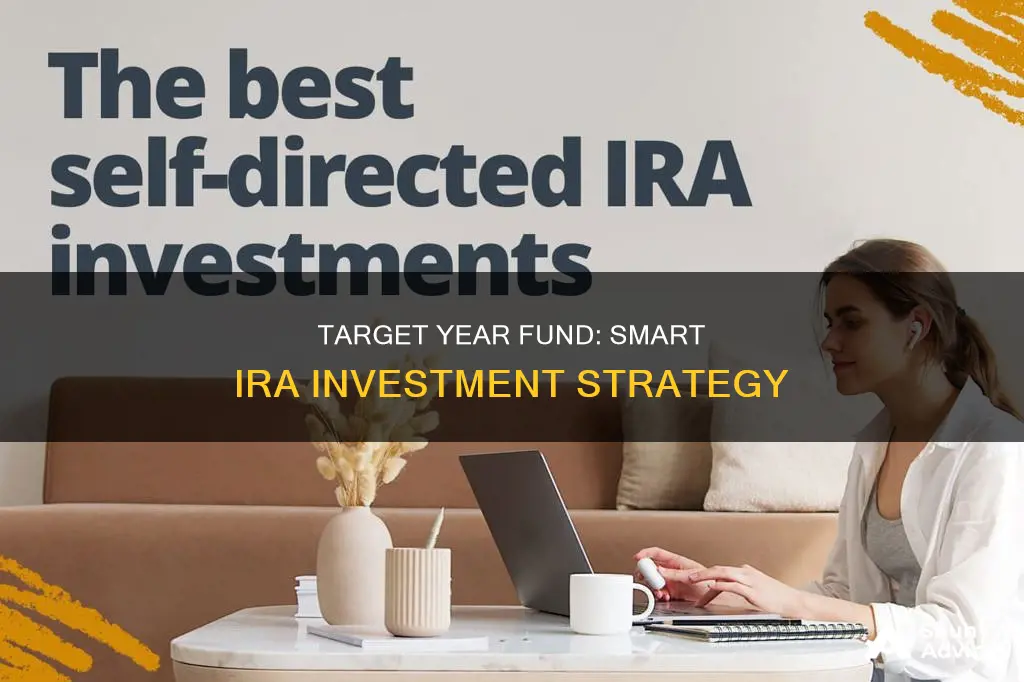
Target-date funds are a popular choice for investors saving for retirement. They are designed to reduce investment risk by rebalancing the portfolio closer to the retirement date. The funds are named according to the target retirement year, and the asset allocation becomes more conservative as the retirement date approaches. While target-date funds are a convenient, hands-off approach, they may not be suitable for everyone as they have a one-size-fits-all strategy and may not provide sufficient growth for longer retirements.
| Characteristics | Values |
|---|---|
| Investment type | High-risk, high-reward (aggressive) to low-risk, low-reward (conservative) |
| Investment approach | Passive |
| Investment funds | Mutual funds, exchange-traded funds (ETFs), individual stocks |
| Investment management | Portfolio manager |
| Investment risk | Not risk-free, may lose money if stocks and bonds drop in value |
| Tax | Tax-advantaged |
| Enrollment | Easy |
| Diversification | Full |
| Rebalancing | Automatic |
| Investment choices | Limited |
| Investor involvement | Not actively involved |
| Glide path | Gradual change in asset allocation over time |
What You'll Learn

The benefits of target-date funds
Target-date funds are a popular choice for investors saving for retirement. They are designed to be the only investment vehicle an investor uses to save for retirement. Here are some of the benefits of target-date funds:
Simplicity
Target-date funds are often referred to as "set it and forget it" funds. They are designed to be simple, allowing investors to pick a fund, put as much as they can into it, and then forget about it until they reach retirement age. This simplicity makes them a good choice for investors who want a hands-off approach to their retirement savings.
Instant Diversification
Target-date funds offer instant diversification among various asset classes, such as equities, bonds, and money market accounts. This diversification can help reduce risk and improve long-term returns.
Professionally Managed Portfolios
Target-date funds are professionally managed, which means investors don't have to worry about making ongoing investment decisions. The fund managers select, monitor, and adjust the investment mix over time based on the investor's target retirement date.
Low Minimum Investments
Target-date funds typically have low minimum investment requirements, making them accessible to a wide range of investors. This also allows investors to instantly diversify their portfolios without needing a large amount of capital.
Discipline
Target-date funds can help investors stay disciplined in their investment choices. By automatically adjusting the asset allocation over time, these funds can prevent investors from making emotional decisions during market twists and turns.
Funding Sources for Private Investment: Where Does Money Come From?
You may want to see also

The drawbacks of target-date funds
Target-date funds have become an increasingly popular choice for investors, but they have some drawbacks that investors should be aware of.
Firstly, these funds are not tailored to individual investors' specific needs. Each target-date fund treats every person retiring in a certain year as having the same income needs, lifestyles, and resources, but this is not the case. Individuals should have a personalised retirement plan, and target-date funds cannot provide this.
Secondly, target-date funds can be too broad. They are often off-the-shelf products, with 80% of target-date assets managed by just five companies. Therefore, workers across different income brackets are offered the same plan, despite their varying income levels. This is problematic because the retirement savings needs of someone in retail sales are different from those in finance, for example.
Thirdly, target-date funds can become too conservative too soon. Research has shown that these funds start becoming too conservative for most people around the age of 50, which may not align with an individual's risk tolerance or financial goals.
Another drawback is the fees associated with target-date funds. As they are structured as funds of funds, there can be multiple layers of fees, which can substantially reduce returns over time. For example, investors may be paying both the expense ratio charged by the fund and the expenses charged by the funds that the target-date fund holds.
Finally, target-date funds may not be optimal from a tax perspective. They can be tax-inefficient as they will sell stocks and buy bonds over time, triggering a taxable event that results in lower bottom-line returns. Additionally, holding a target-date fund in a tax-advantaged account, such as a 401(k), may not be the best strategy as it is more tax-efficient to hold bonds in these types of accounts.
While target-date funds offer simplicity and convenience, investors should be aware of these potential drawbacks and carefully consider whether this investment strategy aligns with their financial goals and risk tolerance.
Funding Your Capital One Investing Account: A Guide
You may want to see also

How to choose a target-date fund
Target-date funds are a "set it and forget it" retirement savings option that removes the headache of deciding on a mix of assets and rebalancing those investments over time. They are also known as life-cycle funds or target-retirement funds. These funds are designed to age with you by automatically rebalancing your portfolio from growth investments toward more conservative ones as retirement nears.
- Look at the fees: The best target-date funds have low annual expense ratios. The cost of a mutual fund is known as its expense ratio, an annual fee expressed as a percentage of your investment. The average target-date fund had an expense ratio of 0.52% in 2020, according to research from Morningstar. But these fees can range from as low as 0.1% to more than 1.5%, so there is room to shop around.
- Know what's inside: Compare funds' investing philosophies. Understand that two identically named funds could have very different strategies for dialling your investments down from a heavier mix of equities toward bonds as you age. The asset-allocation strategy may be too conservative or not conservative enough, depending on your appetite for risk.
- Don't just forget about it: While the set-and-forget nature of target-date funds is a key feature, experts advise looking at your fund's performance at least once a year to ensure it still works for you. Also, look at other investments you hold to ensure you don't have too many overlapping exposures.
- How many years do you have until retirement?: All target-date funds have a year in their title, referring to when the fund assumes an investor will be nearing the traditional retirement age of 65 or so. The farther off the date, the more the fund will emphasise stocks. But over time, the target-date fund will adjust its mix to become more conservative.
- How well-diversified is the fund?: Confirm that the stock portion includes small-cap and mid-cap stocks, not just large-cap stocks. Also, make sure the fund owns international stocks as about 45% of the world's total market capitalization is in companies based outside of the United States.
Vanguard Funds: Where to Invest Your Windfall
You may want to see also

How to invest in a target-date fund
Target-date funds are a popular choice for investors saving for retirement. They are designed to reduce investment risk by automatically rebalancing your portfolio from high-risk, high-reward investments to low-risk, low-reward investments as you near retirement. This is known as the "glide path".
- Understand the basics: Target-date funds are also known as life-cycle funds or target-retirement funds. They are designed to reduce investment risk by automatically rebalancing your portfolio as you age. The "target date" is usually your anticipated retirement year. These funds are best for those who can estimate their retirement age and year.
- Compare funds: Compare funds with similar target dates and examine their investment strategies, fees, and performance so that you can select the one that best matches your tolerance for risk. For example, the Vanguard Target Retirement 2050 Fund (VFIFX) has an expense ratio of .08%, while the Fidelity Freedom 2050 Fund (FFFHX) has a ratio of .75%.
- Pick your target date carefully: Choose a fund with a target date closest to when you plan to retire. For example, if you are 30 years old and plan to retire at 65, choose a fund with a target date of around 35 years in the future.
- Assess your risk tolerance: Understand how comfortable you are with risk and choose a fund with an investment strategy that matches your tolerance. For example, if you are comfortable with a higher level of risk, choose a fund with a higher percentage of stocks.
- Determine whether the fund will take you "to" or "through" retirement: A "to retirement" fund will reach its most conservative asset allocation on the date of the fund’s name and will not change after that. A "through retirement" fund will continue to rebalance and will reach its most conservative asset allocation after the target date.
- Monitor the fund's performance: While target-date funds are designed to be a "set it and forget it" investment, experts advise checking in on the fund's performance at least once a year to ensure it still works for you.
- Choose a brokerage or fund provider: You can open a brokerage account with a fund manager or online broker to shop for target-date funds. Or you can purchase one directly from a fund provider like Vanguard, Fidelity, or T. Rowe Price, but your choices may be more limited.
- Make your investment: Some funds require a minimum initial investment that can range from $500 to $3,000 or more. However, some funds will waive this minimum if you make monthly deposits to your account.
Explore Managed Futures Funds: Diversify Your Investment Portfolio
You may want to see also

How target-date funds compare to other investment options
Target-date funds are a common investment option for 401(k) accounts. They are designed to simplify retirement investing and are especially popular in 401(k) plans, helping workers manage their retirement finances. They are also a good option for those who want to take a hands-off approach to their retirement, at least when it comes to managing their investments.
Advantages of Target-Date Funds
- Diversification: Target-date funds typically invest in a mix of asset classes, providing broad diversification within a single investment vehicle.
- Professional management: Fund managers handle allocating and rebalancing the mix of assets in the portfolio, guided by the fund's target date and risk profile.
- Simplicity: Target-date funds eliminate the need for you to manually adjust your asset allocation over time.
- Put your investing activities on autopilot: A target-date fund eliminates the need to constantly monitor and adjust your portfolio and reduces the stress associated with financial planning by the time you get to retirement.
- Make adjustments if necessary: If your time horizon changes, you can switch to a more applicable fund.
- Increasingly lower fund fees: As target-date funds have become more popular and had to compete against cheaper funds, their fees have come down significantly.
Disadvantages of Target-Date Funds
- Higher fees: Target-date funds often have higher expense ratios than index funds because of the active management involved in adjusting the asset allocation.
- Lack of customization: You'll have limited control over the specific holdings and asset allocation of target-date funds, which may not align perfectly with their personal investment preferences.
- One-size-fits-all approach: Target-date funds follow a preset glide path based on the target retirement date, which may not suit every investor's individual risk tolerance and investment goals.
- Fund expenses can add up: It’s important to compare these before selecting one for your money.
- No earnings are guaranteed: All investments have the potential to lose value.
- Funds may get too conservative too quickly: As you approach your target date, target-date funds move more of your money from stocks to bonds, lowering your overall potential return.
Other Investment Options
Index Funds
Index funds are passively managed mutual funds or exchange-traded funds (ETFs) that track a specific market index, such as the S&P 500. They give you broad exposure to the market and lower costs. They are a straightforward, passive approach to investing, eliminating the need to select individual securities.
Mutual Funds
Mutual funds and letting them grow over the long term is one of the proven ways ordinary people can become everyday millionaires and live the retirement of their dreams. Mutual funds are a good option for those who want to be more hands-on with their investments and are willing to put in the time and effort to research and select the best funds.
First-Time Funds: Why You Should Invest Now
You may want to see also
Frequently asked questions
Target-date funds are investment funds that automatically adjust the risk level of your investments as you near your retirement. They are designed to help manage investment risk and are a popular choice among investors saving for retirement.
Target-date funds are typically structured as mutual funds that invest in other mutual funds. They are designed to reduce investment risk over time, gradually shifting from high-risk, high-reward investments to low-risk, low-reward investments as the target date approaches. The gradual change in asset allocation over time is known as the "glide path".
Target-date funds offer a "set it and forget it" approach to retirement savings, automatically rebalancing your portfolio as you get closer to retirement. They are also easy to enrol in and provide full diversification.
Target-date funds may be too conservative near the retirement date, and investors are not actively involved in investment choices. They may also limit investment choices and decisions and may not provide enough growth potential for people who live longer than expected after retirement.







